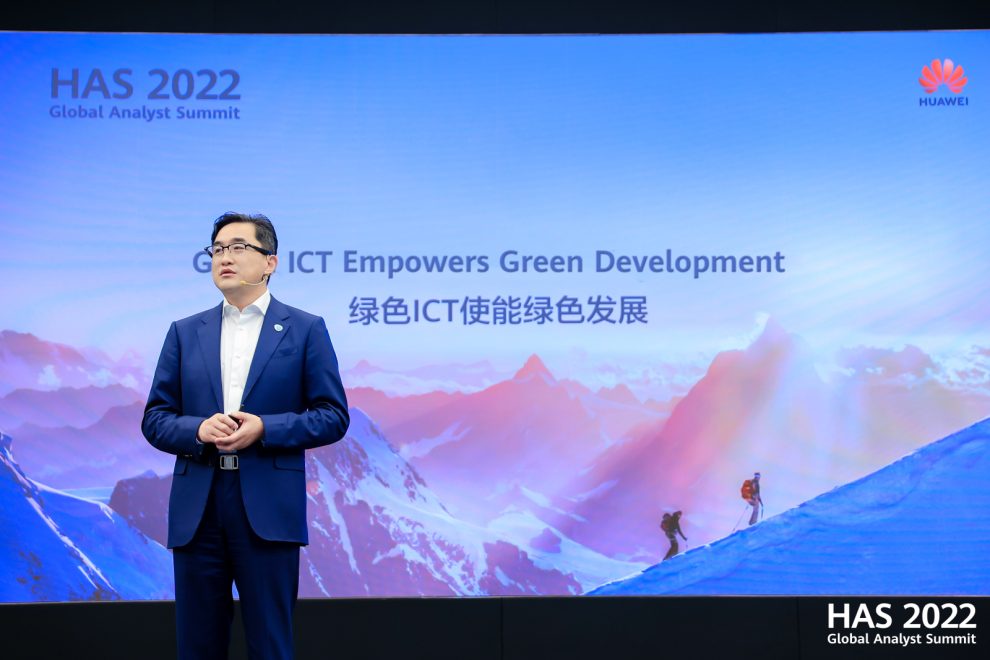Huawei released its Green Development 2030 report at the “Green ICT Empowers Green Development forum” in the Huawei Global Analyst Summit 2022 (HAS 2022) held in Shenzhen, which was attended by analysts, experts, scholars, and journalists from around the world. Presented by Kevin Zhang, CMO of Huawei’s ICT Infrastructure Business, the report systematically outlines how ICT can empower green development.
The Green Development 2030 report is the latest in a series of Intelligent World 2030 reports that systematically present Huawei’s outlook on the future, and provide a general blueprint for the ICT industry’s development and how it can contribute to other industries. The report is developed based on the industry insights and best practices Huawei gathered over the years, and supplemented by input from nearly 100 industry experts and more than 30 third-party organizations including policy makers, associations, think tanks, and enterprises.
The Green Development 2030 report focuses on how digitalization and decarbonization can drive green development, as well as potential applications of green ICT in key industries by 2030. Of note are the six outlooks outlined in Green Development 2030 report, namely,
1. Renewables go mainstream
More than 50% of electricity will come from renewable energy. The share of electricity in global final energy consumption will increase to 30%. The global installed capacity of energy storage systems is expected to increase by 20- fold.
2. The industrial sector will go
Every 10,000 workers will work with 390 robots.
3. Comprehensive electrification in transportation
There will be 145 million new energy vehicles and 100 million private charging piles worldwide.
4. Future buildings will operate at net-zero
All new buildings are expected to operate at net-zero carbon by 2030, with all buildings expected to be net-zero carbon by 2050.
5. Green digital infrastructure is becoming a basic
Digital infrastructure will be 100 times more energy efficient by 2030.
6. Low-carbon living is gaining
The global telemedicine market is expected to increase by over 10-fold. China’s online education is expected to increase by about 23-fold. One billion users will take virtual tours.
The report also explains the three main pathways that future ICT innovation should pursue to empower green development: improving the energy efficiency of digital infrastructure, increasing the share of renewables in electricity generation, and enabling green industries. This will provide insights for green development efforts worldwide.
During his speech at the forum, Zhang said, “Digitalization and decarbonization reinforce each other and jointly drive green development. ICT will be key to both digitalization and decarbonization processes. As a leader in ICT innovation, Huawei is committed to building green ICT infrastructure, accelerating the development of renewable energy, and improving energy savings and emission reductions in a wide range of industries. This is how we hope to promote sustainable development within our society at large.”
The President of Huawei’s SingleRAN Product Line Aaron Jiang also spoke at the forum, explaining Huawei’s practices to build networks with both optimal performance and high energy efficiency, saying, “Huawei’s green 5G solutions are using intelligent technologies to improve the energy efficiency of base stations, and reduce energy consumption across whole networks.”
The forum was attended by a number of industry representatives from the Global Enabling Sustainability Initiative (GeSI), China Mobile, State Grid Yancheng Power Supply Company, BYD, etc. They spoke on their organizations’ own roadmaps and best practices for empowering green development with digital technologies.
GeSI CEO Luis Neves said, “ICT has the potential to enable a 20% reduction of global CO2e emissions by 2030, hold emissions at 2015 levels, and effectively decouple economic growth from emissions growth. This means that the impact of ICT solutions is nearly 10 times higher than ICT’s expected footprint in 2030. An assessment of eight economic sectors – mobility & logistics, manufacturing, food, buildings, energy, work & business, health and learning – shows also that ICT could generate over $11 trillion in economic benefits per year by 2030, the equivalent of China’s expected annual GDP in 2015. At present, the potential of digital technologies is far from being fully harnessed. Those potentials can only be achieved through collective action. This is why GeSI is calling for the ICT Industry to work together through the Digital with Purpose Movement.”
Deputy General Manager of China Mobile’s Planning & Construction Department Li Zhongyan spoke about the operator’s newest “C2 + Three Programs” green action plan, which has been updated to meet carbon emissions peak and carbon neutrality goals. The action plan includes an innovative development model that covers three programs (energy saving, clean energy, and industry enablement) and six green initiatives (green networks, green energy consumption, green supply chains, green offices, green enablement, and green culture). He explained, “The ICT industry is the backbone of the digital economy. As such, China Mobile will play a leading role as an ICT operator by working with academia, research institutes, and industry players both upstream and downstream to create greater synergies.” China Mobile plans to cut energy consumption and carbon emissions per unit of telecom services by at least 20%, reduce its own electricity use by more than 40 billion kWh, and enable other industries to cut emissions by more than 1.6 billion tons by the end of the 14th Five-year Plan period, supporting China’s “dual carbon” goals of reaching the carbon emissions peak by 2030 and carbon neutrality by 2060.
Deputy General Manager of State Grid Yancheng Power Supply Company Wang Guoping said, “We are working to make our Yancheng Low-carbon & Smart-energy Innovation Park a smart, near-zero-carbon campus built on multiple new energy sources. As part of our joint innovation with Huawei, we are using digital technologies to develop applications across four domains – multi-energy integration, smart zero-carbon management, efficient operations, and new services – which will help us increase the share of new energy in our energy mix. We are proud to be participating in the Industrial Internet of Energy Demonstration Campus and Industry-Energy Integration Practice Base initiatives with this project and to contribute to China’s carbon peak and neutrality goals”.
Head of ICT Security at BYD’s Information Center Luo Xiaoping also explained how they are using green optical networks to enable smart manufacturing, and green and low carbon operations. He said, “The new energy vehicle market is developing rapidly. As a market leader, we were excited to build a showcase project in our Changzhou base using Huawei’s green and simplified optical technologies. Huawei’s optical network solution supports simplified architecture, high reliability, and ultra- flexibility, and it is enabling efficient transmissions on our production and office networks. This has allowed us to support growing production capacity.”
Closing out his speech, Kevin Zhang reiterated Huawei’s commitment to collaboration and to using green ICT to empower green development, saying that Huawei would work to provide products with higher energy efficiency and lower energy consumption, use bits to manage watts, and shift from carbon footprint to carbon handprint, to drive the green development for the whole world.












